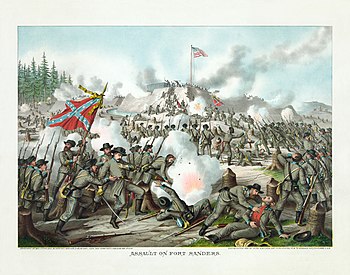
The Battle of Stones River, also known as the Second Battle of Murfreesboro, was a battle fought from December 31, 1862, to January 2, 1863, in Middle Tennessee, as the culmination of the Stones River Campaign in the Western Theater of the American Civil War. Of the major battles of the war, Stones River had the highest percentage of casualties on both sides. The battle ended in Union victory after the Confederate army's withdrawal on January 3, largely due to a series of tactical miscalculations by Confederate Gen. Braxton Bragg, but the victory was costly for the Union army. Nevertheless, it was an important victory for the Union because it provided a much-needed boost in morale after the Union's recent defeat at Fredericksburg and also reinforced President Abraham Lincoln's foundation for issuing the Emancipation Proclamation, which ultimately discouraged European powers from intervening on the Confederacy's behalf.
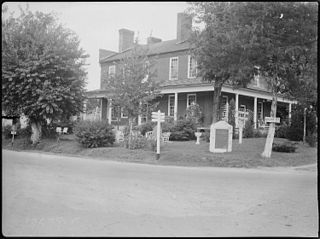
The Battle of Bean's Station was a battle fought in Grainger County, Tennessee, during the Knoxville campaign of the American Civil War. The action saw Confederate forces commanded by Lieutenant General James Longstreet attack Union Army cavalry led by Brigadier General James M. Shackelford. After a clash that lasted until nightfall, Longstreet's troops compelled the Federals to retreat. Two cavalry columns that were intended to envelop Shackelford's force were unable to cut off the Union cavalry, though one of the columns captured 25 Federal wagons. On December 15, Shackelford was joined by some Union infantry southwest of Bean's Station where they skirmished with the Confederates before withdrawing again.

The Battle of Campbell's Station saw Confederate forces under Lieutenant General James Longstreet attack Union troops led by Major General Ambrose Burnside at Campbell's Station, Knox County, Tennessee, during the Knoxville Campaign of the American Civil War. Longstreet hoped to crush the Union Army of the Ohio forces before they could retreat to Knoxville. During the fighting, the Confederates forced the Union troops to fall back from five separate positions. However, the final result was that Burnside's troops conducted a successful fighting withdrawal.

The siege of Knoxville saw Lieutenant General James Longstreet's Confederate forces besiege the Union garrison of Knoxville, Tennessee, led by Major General Ambrose Burnside. When Major General William T. Sherman approached Knoxville with an overwhelming Union force, Longstreet ended the siege on December 4 and withdrew northeast. The siege was part of the Knoxville campaign of the American Civil War.
The following Union Army units and commanders fought in the Battle of Franklin of the American Civil War on November 30, 1864. Order of battle compiled from the army organization during the campaign. The Confederate order of battle is shown separately.
The following Union Army units and commanders fought in the Battle of Nashville of the American Civil War. Order of battle compiled from the army organization during the battle. The Union force was a conglomerate of units from several different departments provisionally attached to George H. Thomas’ Department of the Cumberland. The IV Corps and the District of Etowah were permanently attached to the Department of the Cumberland while the Cavalry Corps had been attached to the Army of the Cumberland until October 1864 when it was transferred to the Military Division of the Mississippi. The XXIII Corps was detached from the Department of the Ohio and Smith’s Corps was detached from the Department of the Tennessee. Other brigades and regiments from the Army of the Tennessee which were unable to rejoin their respective commands were organized into the Provisional Division and attached to the District of the Etowah.
The following Union Army units and commanders fought in the Battle of Antietam of the American Civil War. The Confederate order of battle is listed separately. Order of battle compiled from the army organization during the Maryland Campaign, the casualty returns and the reports.
The following Union Army units and commanders fought in the Battle of Chancellorsville of the American Civil War. The Confederate order of battle is listed separately. Order of battle compiled from the army organization during the battle, the casualty returns, and the reports.

The Knoxville campaign was a series of American Civil War battles and maneuvers in East Tennessee during the fall of 1863 designed to secure control of the city of Knoxville and with it the railroad that linked the Confederacy east and west, and position the First Corps under Longstreet for return to the Army of Northern Virginia. Union Army forces under Maj. Gen. Ambrose Burnside occupied Knoxville, Tennessee, and Confederate States Army forces under Lt. Gen. James Longstreet were detached from Gen. Braxton Bragg's Army of Tennessee at Chattanooga to prevent Burnside's reinforcement of the besieged Federal forces there. Ultimately, Longstreet's Siege of Knoxville ended when Union Maj. Gen. William Tecumseh Sherman led elements of the Army of the Tennessee and other troops to Burnside's relief after Union troops had broken the Confederate siege of Chattanooga. Although Longstreet was one of Gen. Robert E. Lee's best corps commanders in the East in the Army of Northern Virginia, he was unsuccessful in his attempt to penetrate the Knoxville defenses and take the city.

Horace Capron was an American businessman and agriculturalist, a founder of Laurel, Maryland, a Union officer in the American Civil War, the United States secretary of agriculture under U.S. presidents Andrew Johnson and Ulysses S. Grant, and an advisor to Japan's Hokkaidō Development Commission. His collection of Japanese art and artifacts was sold to the Smithsonian Institution after his death.
The following Union Army units and commanders fought in the Battle of Cold Harbor of the American Civil War. The Confederate order of battle is listed separately. Order of battle compiled from the army organization May 31, 1864, army organization May 26-June 3, 1864, the casualty returns and the reports.
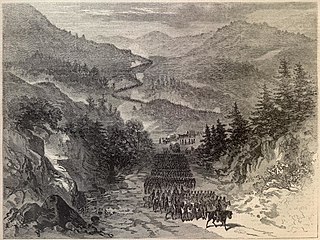
The September 7–9, 1863 fall of the Cumberland Gap was a victory for Union forces under the command of Ambrose Burnside during his campaign for Knoxville. The bloodless engagement cost the Confederates 2,300 men captured and control of the Cumberland Gap.
The following units and commanders fought in the Chattanooga–Ringgold campaign of the American Civil War on the Union side. The Confederate order of battle is shown separately. Order of battle compiled from the army organization during the campaign, the casualty returns and the reports.
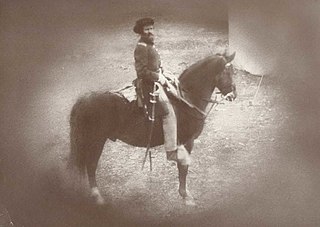
The 5th Regiment Indiana Volunteer Cavalry was a cavalry regiment that served in the Union Army during the American Civil War.

Colvin's Battery Illinois Light Artillery was an artillery battery from Illinois that served in the Union Army during the American Civil War. The battery was organized in October 1863 and served in the Knoxville campaign. The battery campaigned in eastern Tennessee in January 1864 then garrisoned Knoxville for over a year. In March 1865, the unit was re-designed Battery K, 1st Illinois Light Artillery Regiment.
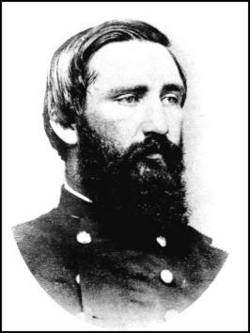
Sanders' Knoxville Raid saw 1,500 Union cavalry and mounted infantry led by Colonel William P. Sanders raid East Tennessee before the Knoxville campaign during the American Civil War. The successful raid began at Mount Vernon, Kentucky and moved south, passing near Kingston, Tennessee. Moving east from the Kingston area, the raiders struck the East Tennessee and Georgia Railroad at Lenoir Station. The Union horsemen rode northeast along the railroad, destroying track, bridges, and property useful to the Confederate States of America. Blocked from seizing Knoxville by its 1,000 Confederate defenders, Sanders' horsemen destroyed a major bridge across the Holston River at Strawberry Plains on the East Tennessee and Virginia Railroad. After wrecking a smaller bridge at Mossy Creek, the raiders turned northwest, evading pursuers by slipping through an obscure gap in the Cumberland Plateau. Sanders' men reached Boston, Kentucky on June 24, having captured and paroled over 400 Confederate soldiers while sustaining minimal losses in men but considerable losses in horses.

The Battle of Philadelphia saw the Confederate cavalry brigades of Colonels J. J. Morrison and George Gibbs Dibrell attack a Union cavalry brigade under Colonel Frank Wolford at Philadelphia, Tennessee, during the Knoxville campaign of the American Civil War. While Dibrell's brigade skirmished with Wolford's cavalrymen, Morrison led his brigade around the west side of Philadelphia to attack the Union force from the rear. Wolford sent half his brigade to counter Morrison's envelopment, but Dibrell's soldiers suddenly attacked. The Confederates completely routed Wolford's troopers, capturing over 400. A Union infantry-cavalry force reoccupied Philadelphia the next day, but a week later it withdrew to the north bank of the Tennessee River, abandoning Loudon, Tennessee.

The Battle of Walker's Ford saw three Confederate cavalry brigades led by Brigadier General William T. Martin attack a Union cavalry brigade under Colonel Felix W. Graham at Walker's Ford on the Clinch River during the Knoxville campaign of the American Civil War. After failing to trap Graham's brigade at Maynardville, Tennessee, Martin's cavalry pursued in the direction of Tazewell before encountering Graham's horsemen south of Walker's Ford in the morning. At first, Martin's cavalry pressed Graham's troopers back. However, Brigadier General Orlando B. Willcox arrived with a Union infantry brigade and repulsed the Confederate cavalry. Martin sent a cavalry brigade to envelop the Union force, but it was blocked by one of Graham's regiments at a nearby ford. Martin's Confederates soon withdrew toward Knoxville. Willcox's tentative probe failed to relieve Major General Ambrose Burnside's defenders in the Siege of Knoxville, but Major General William T. Sherman's much larger forces soon accomplished that task.
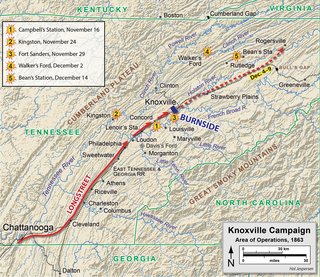
The Battle of Kingston saw Major General Joseph Wheeler with two divisions of Confederate cavalry attempt to overcome the Union garrison of Kingston, Tennessee, led by Colonel Robert K. Byrd. The Confederates mistakenly believed that the Kingston garrison was weak, but in fact, it comprised a brigade of infantry and a regiment of mounted infantry. When Wheeler's cavalrymen began probing the Union position, they discovered that its defenders were too numerous, and the position was too strong. The Confederate cavalry withdrew to rejoin Lieutenant General James Longstreet's forces in the Siege of Knoxville, but Wheeler himself returned to the Army of Tennessee near Chattanooga.

The following Union Army units and commanders fought in the Meridian campaign of the American Civil War. Order of battle was compiled from the army organization during the campaign. The strength numbers listed in the tables are "present for duty".
